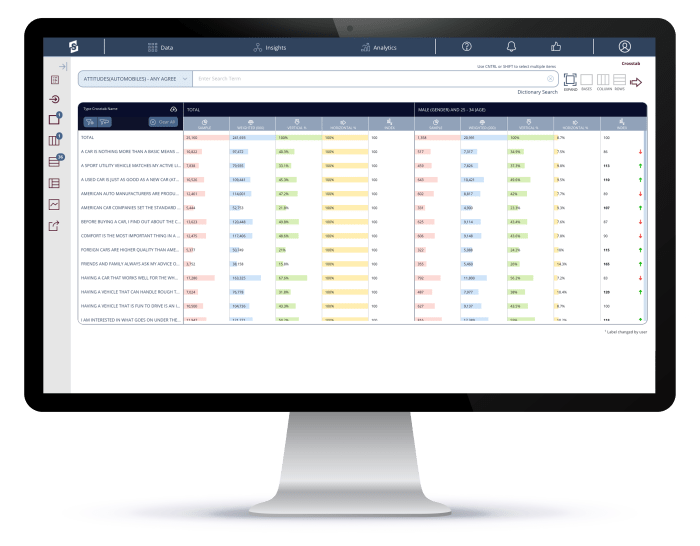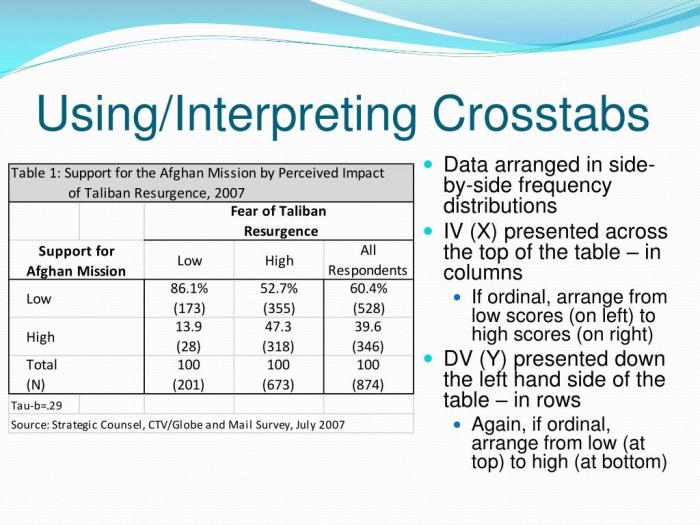Delving into the intricacies of how to read MRI Simmons Crosstab, this comprehensive guide unravels the secrets of this powerful tool, empowering marketers with the knowledge to unlock deep market insights and drive successful campaigns.
MRI Simmons Crosstab, a cornerstone of market research, offers a wealth of demographic and consumer behavior data, providing a roadmap to understanding target audiences, identifying market opportunities, and optimizing marketing strategies.
Introduction to MRI Simmons Crosstab
The MRI Simmons Crosstab is a comprehensive tool used to analyze the relationship between two categorical variables in a research study.
It is widely employed in market research, particularly in the television industry, to understand audience behavior and preferences. The crosstab presents the frequency distribution of one variable across the categories of the other variable, providing insights into the relationship between the two.
Data and Methodology
The MRI Simmons Crosstab utilizes data collected from the MRI (Mediamark Research Inc.) Simmons National Consumer Study, which surveys a large and representative sample of the US population.
The study gathers information on various aspects of consumer behavior, including media consumption, product usage, and lifestyle habits. The crosstab analysis involves examining the relationship between two variables of interest, such as TV viewership and product purchase behavior.
Understanding the Crosstab Layout
The MRI Simmons Crosstab is structured as a table with rows representing the target audience and columns representing the media vehicles. The crosstab is divided into several sections, each representing a different demographic or psychographic category.
Sections and Categories
The main sections of the crosstab include:
- Demographics: This section includes categories such as age, gender, income, and education level.
- Psychographics: This section includes categories such as lifestyle, interests, and attitudes.
- Media Vehicles: This section includes categories such as television, radio, print, and online.
Within each section, the categories are further broken down into subcategories. For example, the demographics section may include subcategories such as age groups (18-24, 25-34, etc.) and income levels (under $50,000, $50,000-$100,000, etc.).
Interpreting the Data
To interpret the data in the crosstab, look for patterns and trends. For example, you may notice that a particular demographic group is more likely to be exposed to a certain media vehicle than another. You can also compare the data across different sections to see how different demographic and psychographic groups differ in their media consumption habits.
For example, if you are interested in reaching women between the ages of 25 and 34, you would look at the row for that demographic group in the crosstab. You would then look at the columns for different media vehicles to see which ones reach the highest percentage of women in that age group.
Analyzing Demographic Data
Demographic data in the MRI Simmons Crosstab provides valuable insights into the characteristics of the target audience. It allows marketers to understand the age, gender, income, education level, and other relevant demographic attributes of their potential customers.
To extract and interpret demographic information, identify the relevant variables in the crosstab. These variables are typically presented in rows or columns and may include categories such as age groups, gender, income ranges, education levels, and geographic regions.
Identifying Key Demographic Variables
The key demographic variables in the MRI Simmons Crosstab include:
- Age
- Gender
- Income
- Geographic region
- Marital status
- Household size
li>Education level
These variables provide a comprehensive overview of the target audience’s demographic profile, enabling marketers to tailor their campaigns accordingly.
Exploring Consumer Behavior
The MRI Simmons Crosstab provides valuable insights into consumer behavior, allowing marketers to understand the purchasing habits, media consumption, and other behaviors of their target audience.
Purchasing Habits
The crosstab reveals patterns in consumer purchasing behavior, such as preferred brands, product categories, and purchase frequency. By analyzing this data, marketers can identify potential customers, target specific demographics, and develop targeted marketing campaigns.
Media Consumption
The crosstab also provides insights into media consumption habits, including preferred TV shows, magazines, and websites. This information helps marketers optimize their media placements and develop content that resonates with their target audience.
Other Behaviors
Beyond purchasing habits and media consumption, the crosstab can reveal insights into other consumer behaviors, such as travel preferences, dining habits, and recreational activities. This data can help marketers develop marketing campaigns that are tailored to the specific interests and lifestyles of their target audience.
Identifying Market Opportunities

The MRI Simmons Crosstab provides valuable insights into market opportunities by revealing patterns and trends within consumer behavior. By analyzing the crosstab data, businesses can identify potential target audiences, segment the market effectively, and develop targeted marketing strategies.
Segmenting the Market
- The crosstab allows marketers to segment the market based on demographic characteristics, such as age, gender, income, and education.
- This segmentation helps businesses identify specific groups of consumers with distinct needs and preferences.
- By understanding the unique characteristics of each segment, businesses can tailor their marketing messages and products accordingly.
Targeting Specific Audiences
- Once the market has been segmented, the crosstab data can be used to target specific audiences for marketing campaigns.
- By focusing on audiences that are most likely to be interested in their products or services, businesses can optimize their marketing efforts and increase their chances of success.
- The crosstab data can help identify specific media channels and platforms that are most effective for reaching each target audience.
Developing Effective Marketing Strategies
- The insights gained from the MRI Simmons Crosstab can be used to develop effective marketing strategies that resonate with specific target audiences.
- By understanding the consumer behavior, preferences, and motivations, businesses can create marketing campaigns that are relevant and engaging.
- The crosstab data can also help businesses identify opportunities for product development and innovation.
6. Advanced Analysis Techniques: How To Read Mri Simmons Crosstab

The MRI Simmons Crosstab provides a wealth of data, and advanced analytical techniques can help researchers extract even deeper insights from it. These techniques include:
- Statistical analysis: Statistical techniques, such as t-tests, ANOVA, and regression analysis, can be used to identify statistically significant differences between groups and to test hypotheses about the relationships between variables.
- Regression modeling: Regression modeling is a statistical technique that can be used to predict the value of a dependent variable based on the values of one or more independent variables. Regression models can be used to identify the factors that are most strongly associated with a particular outcome, and to make predictions about future outcomes.
- Other methods: Other advanced analytical techniques that can be applied to the MRI Simmons Crosstab include cluster analysis, factor analysis, and discriminant analysis. These techniques can be used to identify groups of respondents with similar characteristics, to reduce the dimensionality of the data, and to classify respondents into different groups.
Example
For example, a researcher might use regression modeling to identify the factors that are most strongly associated with brand loyalty. The researcher could then use this information to develop marketing campaigns that are targeted to specific groups of consumers.
Best Practices for Crosstab Analysis
To ensure effective crosstab analysis, it is essential to adhere to certain best practices that minimize bias and enhance accuracy. These practices encompass data preparation, interpretation, and presentation.
Data Preparation
Prior to analysis, the data must be carefully prepared to ensure its integrity and relevance. This involves:
- Cleaning and validating the data to eliminate errors and inconsistencies.
- Categorizing variables appropriately to facilitate meaningful comparisons.
- Ensuring the sample size is sufficient for statistical validity.
Interpretation, How to read mri simmons crosstab
When interpreting the crosstab results, it is crucial to consider the following:
- Examining the overall patterns and trends within the data.
- Identifying statistically significant differences between categories.
- Avoiding over-interpreting the results and making unwarranted conclusions.
Presentation
The presentation of crosstab analysis results should be clear and concise, enabling readers to easily understand the findings. This includes:
- Using tables and graphs to visualize the data effectively.
- Providing clear and concise explanations of the results.
- Avoiding unnecessary jargon and technical language.
General Inquiries
What is MRI Simmons Crosstab?
MRI Simmons Crosstab is a comprehensive market research tool that provides detailed demographic and consumer behavior data, enabling marketers to gain deep insights into their target audience.
How do I interpret the data in an MRI Simmons Crosstab?
The Crosstab is structured with rows representing demographic variables and columns representing consumer behavior categories. Each cell displays the percentage of respondents who meet the criteria of both the row and column variables.
How can I use MRI Simmons Crosstab to identify market opportunities?
By analyzing the data in the Crosstab, marketers can identify underserved market segments, emerging trends, and potential growth areas, enabling them to tailor their marketing strategies accordingly.